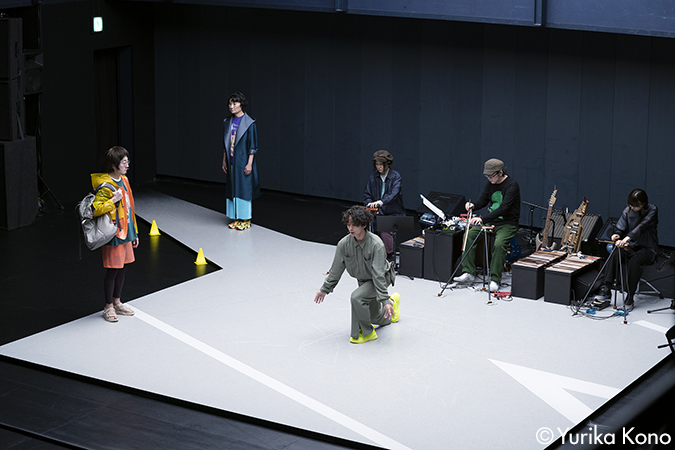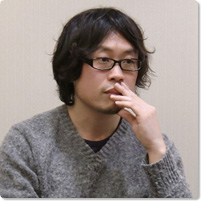Noh “Zaha”
**
Based on the traditional convention of “dream Noh,” the characters appearing in the play include a Japanese architect (as Mae Shite, the leading role in the first half of a Noh play), a tourist (as the Waki, a supporting actor), a resident of the neighborhood (as the Ai, a local inhabitant), and [the ghost of] Zaha Hadid (as the Nochi Shite, the leading role in the latter half of a Noh play). Also, a singer takes the part of the Utai (the chanter of the Noh narrative).
**
The year is 2018. A tourist who has come to see the construction site of Tokyo’s New National Stadium plans to make a full circle around the stadium while taking in the sights, but he finds the distance to be more than he expected and sits down to rest against the handrail of the pedestrian bridge between it and the Tokyo Metropolitan Gymnasium.
There, the tourist sees a person looking intently at the construction site and, finding something strange about the person’s presence, he decides to speak to him. The person says that he is trying to envision what the stadium would have looked like in its original design by Zaha Hadid. When the tourist says that he had heard Zaha’s plan was rejected because the design was not popular and the cost of construction was too high, the person refutes, “So, you are one of those who were convinced by the vicious campaign against that architect and her design.”
The person goes on speaking: “Even though Zaha’s stadium design with its futuristic vision had won the design competition, we overthrew that decision and got rid of her plan by shifting the responsibility for the dispute onto others’ shoulders. They probably thought that, even if we broke the promise of the commission, a seemingly strong-willed female architect from overseas would just accept it and walk away.”
The tourist asks the person why he is still so concerned about the issue even though the dispute about the new plan has quieted down, the construction is underway, and everyone is now just hoping that the Olympics scheduled for the year after next will open with no problems. The person then reveals that he is also an architect and is still disturbed about the way the original (Zaha) plan for the stadium, which was to have been finished by now, was unjustly discarded.
The tourist and the architect go on to converse, saying, “Everyone made Zaha the scapegoat.” At this point, the singer (in the role of the Noh Utai chanter) begins to sing: “Ignoring the essence of the problem / without due discussion / they make her the scapegoat.” The song goes on: “They couldn’t object to the flow.” “Even if everyone forgets it all in time / let us continue to regret.” “The stadium we longed for which will never be built.” “There it stands as a giant zero.”
As the song comes to an end, the man who turned out to be an architect leaves the stage.
The tourist begins asking around to see if he can find someone who is a resident of the neighborhood, and finally one appears. The resident looks to be on a habitual walk. The tourist explains about the encounter he has just had and asks the resident if he has seen the suspicious architect here before. The resident replies that indeed he has seen the architect, who believes we are the ones who killed Zaha.
The resident explains that the Zaha design for the new stadium was one of the things that was supposed to have strengthened Tokyo’s bid to host the Olympics, and to then simply throw out the plan later was simply too unjust. The fact that the cost of the Zaha plan spiraled out of control was actually mostly due the design requirements imposed by the Tokyo side and their lack of cost control measures. Nonetheless, everyone put all the blame for the problems on Zaha’s side, and the mood of society at large fueled that argument. In other words, it was the unwillingness of the system at large to accept responsibility for the problem that killed Zaha.
When we look down on the finally completed New National Stadium from above, we will see that it has the shape of a large zero. So, it will stand as a huge monument that won’t let us forget the way the Zaha design was discarded and reduced to a zero base.
After delivering this explanation, the local resident leaves the stage.
As the wind blows harder, the tourist stands looking at the construction site of the New National Stadium with new eyes as a huge monument, and it is then that ghost of Zaha appears. Zaha talks about the vision she based her design on, while the singer sings in chorus with her.
“Overlapping layers / reflection of the world’s complexities / signposts to reality / reverse keels rising to the blue sky. The complexity of countless lines eliminates any borders, structure and the surroundings, urban planning, all blend together as the same elements. A form that leaves complexity as it is: complex.”
“Computer calculations and three-dimensional modeling translate movement and energy into architectural forms in ways that stimulate the movements of Tokyo itself. In the face of the increasingly gloomy entanglements of the world, we need stimulation and fiction to believe in the future. That fiction would land in the Sendagaya area of Tokyo from out in the universe with its streamlined form. It would bring strength to the city and the planet.”
“And with the strength Tokyo would gain from the Zaha stadium would come a vision to survive in the increasingly unforeseeable future of our world.”
Having spoken thus, Zaha leaves, followed by the tourist.
Noh “Tsuruga”
**
Appearing are: the woman on the shore (as Mae Shite, the leading role in the first half of a Noh play), a traveler (as the Waki, a supporting actor), a resident of the neighborhood (as the Ai, a local inhabitant), and ghost of Nuclear Fuel Recycling Policy (as the Nochi Shite, the leading role in the latter half of a Noh play). Also, a singer takes the part of the Utai (the chanter of the Noh narrative).
**
The setting is September. A traveler is driving his car down the coastal road along the Sea of Japan in Fukui Prefecture. Finally, he arrives at his destination, the Shiraki Kaigan shore in Tsuruga city. From this shore, which also has a small fishing port, one can see the fast-breeder nuclear reactor Monju that is now in the process of being decommissioned. The traveler decides to spend some time on this unfrequented shore looking at the sea and sky and the view of the Monju reactor facility.
On the shore of what was supposed to be a deserted beach, a woman stands near the water’s edge. When the traveler asks her if she is enjoying the view of the sea and sky, the woman says she is not. When the traveler says that it is a nice view except for the presence of the Monju buildings, the woman criticizes him for such a heartless statement based only on what meets the eye.
The woman and singer (Utai) sing in chorus.
“Those white buildings were supposed to have made the dream of fast-breeder nuclear power come true. But that dream of plutonium being a source of energy that lasted forever without depleting never came to fruition. I know that it is time for me to wake up from that dream, but I want to linger in it a little longer. I know that we have to accept the decision to shut it down forever, but I don’t know what to do. That is why I linger on this shore between the dream and reality.”
When the traveler asks her about her relationship with the Monju reactor, once again she and the singer sing in chorus.
“At first, I saw it as the ideal nuclear reactor I had dreamed of. Bombarding the nucleus of uranium molecules with neutrons at high speed increases the amount of plutonium produced. But that was considered an impossibly difficult task for mankind to achieve. Nonetheless, we were made to dream that it could be possible using Japanese technology.”
“In 1995, just three months after the start of test operation of the fast-breeder nuclear reactor Monju, a leak of liquid sodium from a sodium coolant pipe caused a fire when it came in contact with air and water, which in turn caused a hole to open in the concrete floor. It turned out to be a hole that destroyed the myth of the reactor’s safety. The Monju reactor had to be decommissioned for the next 20 years.”
“I am the incarnation of Monju. How can I rid myself of the regret I carry as the burden of the dream that was left unfulfilled along with the radioactive waste that led to the ultimate decommissioning of the reactor?”
When the song ends, the woman on the shore leaves.
A local resident appears (as the Ai). The traveler asks the person if he is a local resident, and saying that, if so, he wants ask him something. When he starts by mentioning Monju, the local resident cuts him off, saying, “We have nothing to say about it to outsiders.”
The local resident goes on to say that outsiders who try to ask about Monju are mostly impolite, and they are unable to imagine what the local situation has been. They don’t understand what it means to have a dream. The dream of seeking local revitalization of the depopulating Tsuruga Peninsula was once also the dream of people around the world. The world would have been grateful if the project here could have solved the energy problem. And isn’t it true that the ability to have embraced such a dream is not something that can be fully judged from the perspective of outsiders, or from the perspective of contemporary values?”
“What are we to do if we are now told to wake up from that dream? There is no one who is now willing to take responsibility for what happened over the past 30 years. That dream of our past was probably dismissed with suitable words in order to save the position or the reputation of some officials on high.”
After saying this, the local resident leaves. Before we realize it, the day is nearing dusk.
Here appears the ghost of the Nuclear Fuel Recycling Policy to sing in chorus with the singer.
“The transport ship named Akatsuki is carrying a load of plutonium produced in France to Japan. There are objections to this shipment. Because the Panama Canal objects to passage of this shipment, the ship has to take the long route around the Cape of Good Hope. The Strait of Malacca also forbids passage of the cargo and the ship is forced to take a southern route around Australia. After all these detours, the ship arrives at Tokai-mura, but the [process for] recycling of the nuclear fuel is still far from completion”
“There is a sense that the project will end before it ever begins. The dream of the Tsuruga Peninsula’s future, the dream of the peaceful use of nuclear energy and the dream of ending the history of human conflict for energy seem to be collapsing. The result becomes a monster that holds the fate of all these dreams.”
“The monster that was the concept of nuclear fuel recycling seems to have transformed into a zombie before it was ever born. Even the wish that it would all disappear will never be realized. Will the radioactivity remain for tens of thousands of years, accompanied only by the sound of the waves?”
With this narration, the ghost of the Nuclear Fuel Recycling Policy and the traveler both leave the stage.



